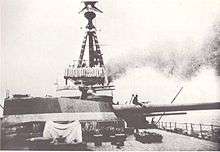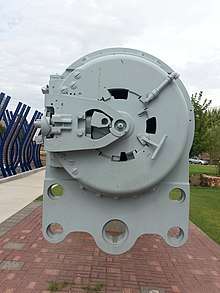14"/45 caliber gun
The 14"/45 caliber gun, (spoken "fourteen-inch-forty-five-caliber"), whose variations were known initially as the Mark 1, 2, 3, and 5, and, when upgraded in the 1930s, were redesignated as the Mark 8, 9, 10, and 12. They were the first 14-inch (356 mm) guns to be employed with the United States Navy. The 14-inch/45 caliber guns were installed as the primary armament aboard all of the United States Navy's New York-class, Nevada-class, and Pennsylvania-class battleships. The gun also saw service in the British Royal Navy, where it was designated the BL 14 inch gun Mk II.
| 14"/45 caliber gun | |
|---|---|
| Type |
|
| Place of origin | United States |
| Service history | |
| In service | 1914–1946 |
| Used by | |
| Wars | |
| Production history | |
| Designer | Bureau of Ordnance |
| Designed |
|
| Manufacturer | |
| Variants | Marks 1–3, 5, 8–10, 12 |
| Specifications | |
| Mass |
|
| Length | 53 ft 6.5 in (16.32 m) |
| Barrel length | 52 ft 6 in (16.00 m) bore (45 calibers) |
| Shell |
|
| Caliber | 14 in (356 mm) |
| Recoil | 40 in (1,000 mm) |
| Elevation |
|
| Traverse | -150° to 150° |
| Rate of fire | 1.25–1.75 rounds per minute |
| Muzzle velocity |
|
| Effective firing range | 13,000 yd (12,000 m) at 7.4° elevation |
| Maximum firing range |
|
History
The design of the 14-inch/45 caliber dates to about 1910. They entered service in 1914 aboard Texas and her sister ship New York shortly after. At the time of their introduction they were intended to fire 1,400 lb (640 kg) armor-piercing (AP) projectiles containing a bursting charge of explosive D.[1] Propellant charge was four silk bags of smokeless powder, each of which weighed 105 lb (48 kg).[2] At a 15 degree angle, the guns could fire a shell out to 23,000 yd (21,000 m). Each individual gun weighed 142,492 lb (64,633 kg) with the breech and measured 53 ft 6.5 in (16.32 m) in length.[3]
Each of the original Mark 1 built-up guns consisted of a tube without liner, jacket, eight hoops and a screw box liner. To compensate for the problem of gun drooping, four hoop-locking rings were added to the guns. The Mark 3 added three hoop locking rings and contained a longer slide, while the Mark 5 had five hoops total. Owing to the interchangeability of the guns, the battleships fitted with the 14-inch/45 caliber guns often had guns of various Marks installed on each turret.[3]
In the 1930s, the Mark 1, 2, 3, and 5 were upgraded to allow for increased charges and muzzle velocities, resulting in the Mark 8, 9, 10, and 12, respectively. All guns employed a Welin breech block and used a Smith-Asbury mechanism, and in the case of the Mark 12 chromium plating was introduced to prolong barrel life. These improvements enabled the guns to fire heavier 1,500 lb (680 kg) shells, and increasing the gun mount elevation to 30 degrees[2] extended the range of the guns to 36,000 yd (33,000 m). The New York-class did not have their turrets modernized because their shell hoists could not accommodate the longer AP and HC shells, instead, a shorter version of shells with windshields were produced for them.[4]
Naval action
United States Navy
_fire_on_positions_ashore.jpg)
The guns on the two battleships of the New York-class, New York and Texas, the first ship of the Nevada-class, Nevada and the first ship of the Pennsylvania-class, Pennsylvania, saw service in World War II in the role of shore bombardment. New York bombarded North Africa during landings in 1942, Pennsylvania took part in the Aleutian Islands Campaign and Texas and Nevada shelled Normandy during Operation Overlord in 1944. Throughout 1944 and 1945, Pennsylvania hit many different Pacific islands during their invasions,[5] while New York, Texas and Nevada all took part in the invasion of Iwo Jima and the invasion of Okinawa in 1945.[6][7][8]
Due to the attack on Pearl Harbor, both Oklahoma and Arizona never fired their main batteries in anger. However, three 14-inch/45 caliber guns formerly on Arizona and in the relining process at the time of Pearl Harbor were installed aboard Nevada in the fall of 1944 and were used in several shore bombardments in the Pacific.[9] The aft turrets from Arizona (numbers 3 and 4) were moved to become United States Army Coast Artillery Corps Battery Arizona on the west coast of Oahu and Battery Pennsylvania on Mokapu Point.[10][11]
Royal Navy

Eight US Navy standard 14-inch/45 caliber guns, complete with mountings, built by Bethlehem Steel, were supplied to the United Kingdom in World War I. They were mounted on Abercrombie-class monitors under the British service designation BL 14 inch gun Mk II.[12]
Naval service
| Ship | Gun Installed | Gun Mount |
|---|---|---|
| USS New York (BB-34) | Guns: 14"/45 caliber | Turrets: 5 × twin-gun turrets |
| USS Texas (BB-35) | Guns: 14"/45 caliber | Turrets: 5 × twin-gun turrets |
| USS Nevada (BB-36) | Guns: 14"/45 caliber |
|
| USS Oklahoma (BB-37) | Guns: 14"/45 caliber |
|
| USS Pennsylvania (BB-38) | Guns: 14"/45 caliber | Turrets: 4 × triple-gun turrets |
| USS Arizona (BB-39) | Guns: 14"/45 caliber | Turrets: 4 × triple-gun turrets |
| Abercrombie (1915) | Guns: 14"/45 caliber | Turrets: 1 × twin-gun turrets |
| Havelock (1915) | Guns: 14"/45 caliber | Turrets: 1 × twin-gun turrets |
| Raglan | Guns: 14"/45 caliber | Turrets: 1 × twin-gun turrets |
| Roberts (1915) | Guns: 14"/45 caliber | Turrets: 1 × twin-gun turrets |
See also
- 14"/50 caliber gun - later 14" gun (American)
- BL 14 inch Mk VII naval gun - for British Royal Navy King George V-class battleships (1939)
- Greek battleship Salamis
Weapons of comparable role, performance and era
- 14-inch gun M1910 US Army coast defense equivalent
- EOC 14 inch /45 naval gun contemporary British equivalent
- Vickers 14 inch/45 naval gun contemporary Vickers-designed Japanese equivalent
- 340mm/45 Modèle 1912 gun contemporary French naval gun
Surviving examples


- On USS Texas (BB-35) at San Jacinto Battleground, near Houston
- Wesley Bolin Memorial Plaza, memorial to USS Arizona and World War II, Phoenix, Arizona; one of three previously on Arizona that served on Nevada in World War II
- Pennsylvania Military Museum, Boalsburg, Pennsylvania
Notes
- Fairfield, A.P. Naval Ordnance Lord Baltimore Press (1921) p. 560
- Campbell, John Naval Weapons of World War Two Naval Institute Press (1985) ISBN 0-87021-459-4 p. 121
- DiGiulian, Tony (11 July 2016). "14"/45 (35.6 cm) Marks 1, 2, 3 and 5". Navweaps.com. Retrieved 19 October 2016.
- DiGiulian, Tony (15 July 2016). "14"/45 (35.6 cm) Marks 8, 9, 10 and 12". Navweaps.com. Retrieved 19 October 2016.
- "Pennsylvania II (Battleship No. 38)". Dictionary of American Naval Fighting Ships. Navy Department, Naval History and Heritage Command. 1 December 2015. Retrieved 15 September 2016.
- "New York V (Battleship No. 34)". DANFS. 18 February 2016. Retrieved 15 September 2016.
- "Texas II (Battleship No. 35)". DANFS. 18 February 2016. Retrieved 15 September 2016.
- "Nevada II (Battleship No. 36)". DANFS. 18 February 2016. Retrieved 15 September 2016.
- "Phoenix, Arizona – USS Arizona Anchor and Mast". Roadside America.com. 15 July 2011. Retrieved 16 July 2011.
- Lewis, Emanuel Raymond. Seacoast Fortifications of the United States: An introductory history. Annapolis, MD: Naval Institute Press (1979). ISBN 978-1-55750-502-6 p. 123
- FortWiki article on Hawaii turret batteries
- Tony DiGiulian, British 14"/45 (35.6 cm) Marks II, IV and V
Bibliography
- Lewis, E. R. & Kirchner, D. P. (1992). "The Oahu Turrets". Warship International. XXIX (3): 273–301. ISSN 0043-0374.
External links
| Wikimedia Commons has media related to 14"/45 caliber naval gun. |